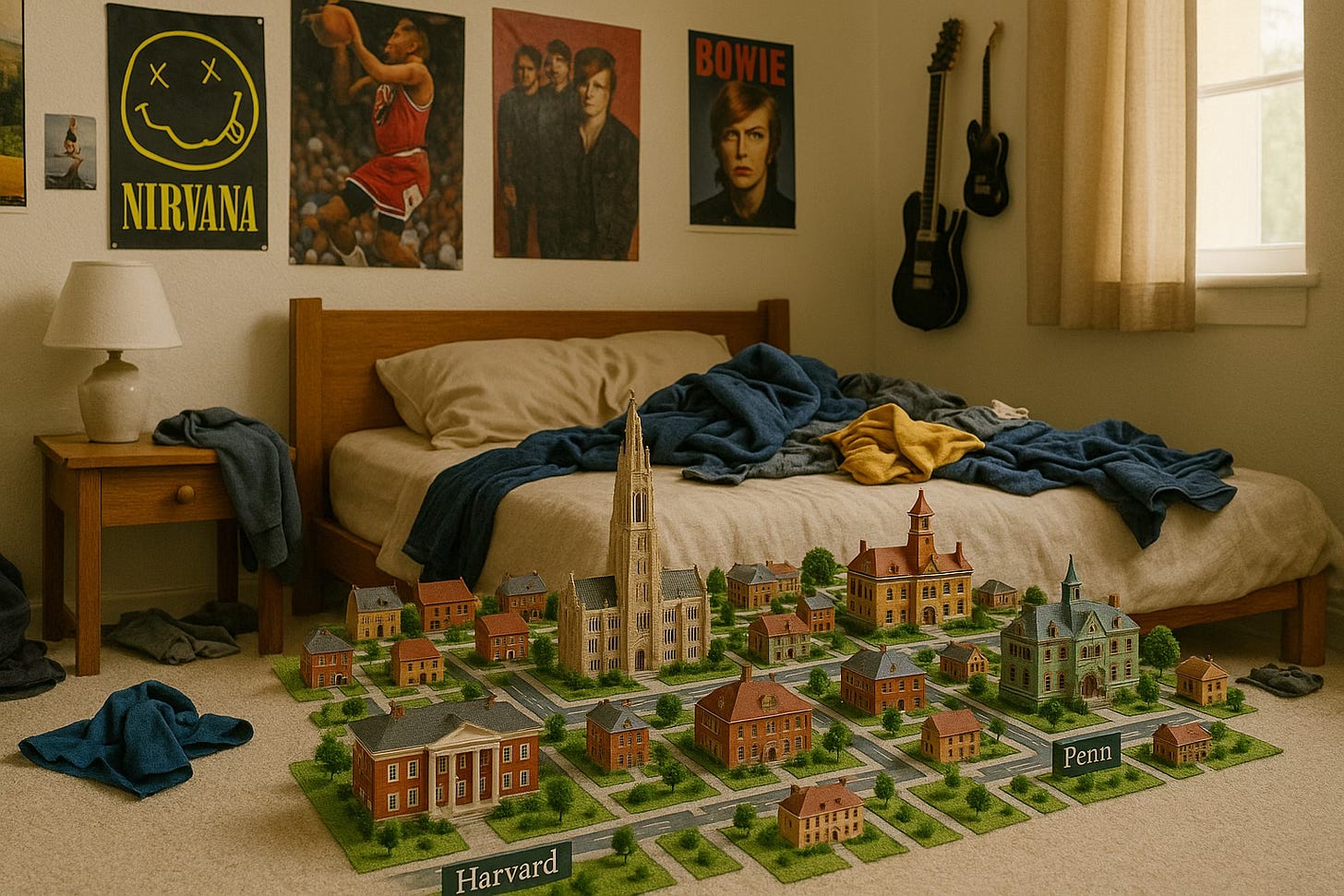The blue collar workers of our white collar world are rejoicing. AI has made them faster, smarter and better, one image, one word, one LinkedIn post at a time.
This is just the beginning.
Next, it will shake up the white collared brand owners, creators, and knowledge workers.
Over the last two weeks, Chinese reels have flooded our phones and told us that a $1,000 LV costs just $300 to produce and this way, they have forced us to recalibrate what luxury brands mean to us.
AI will leave the Chinese far behind and will set up not just a hi-tech chinese factory, but also the entire Ivy League inside our homes.
Here’s a peak into a very-likely-future.
Scenario 1: Mira’s Birkucci : moats of production, shattered
The AI flex:
AI has already accelerated Moore’s law (as the power of technology doubles, its cost halves). Moore’s law+AI will make IoT (Internet of things) affordable. Think 3-D printers at the cost of regular printers.
Democratisation of production:
Mira is a fashion influencer. Through some clever AI prompting, she imagines a handbag that combines the design elements of a Birkin and a Gucci.
She 3D prints her Berkucci in the comfort of her home on her five thousand rupee 3-D printer.
A few reels later, her DMs are flooded and she starts selling hundreds of Birkuccis to her thirsty community.

Mira’s business model:
- Overheads = AI subscriptions
- Capex = 3-D printer cost
- Opex = high quality material she prints the Birkucci with + courier cost
- Marketing cost = zero (since she has a community)
If she can keep exciting her community with new, interesting designs, she can keep this business going for a while.
Scenario 2: Ram’s MBA GPT: knowledge moats, shattered
The AI flex:
Knowledge workers are already building their own GPTs. Soon enough, they might launch subscription revenue models, so we will be able to subscribe to Hariri GPT and ask him questions, and even debate with him.
Conference organisers would no longer need to fly in thought leaders from overseas. They would subscribe to the best GPTs and have fireside chats with them.
Hell, they could even, for the right price, get Trump GPT, Putin GPT and Zelenskyy GPT for a panel discussion!
Tomorrow, GPT subscriptions will be like today’s newsletter and podcast subscriptions.
But wait, it gets more interesting.
Democratisation of universities:
Ram is in a full time job but he wants to learn more. In fact, he wants to do an MBA.
But there’s a caveat.
In a post-degree world, he wants the nutrition of an MBA education without the cholesterol of the fees and the diabetes of no salary for two years.
So he curates the books, articles, interviews, tweets, everything he can find, from ten of the world’s best thinkers and professors and creates his own MBA degree.

He shows off his MBA GPT to his friends. They love it and want him to monetise it.
Ram’s business model:
- Overheads = zero
- Capex = zero
- Opex = subscriptions to knowledge GPTs. Zero logistics cost because as a software product, the marginal cost for each additional unit sold is zero
- Marketing cost = acquisition costs- as much or as little he wishes to spend
Ram’s MBA GPT will only get better as more students work with it, ask questions and synthesise its insights.
Not just this, it will continuously soak up everything these professors publish, in real time.
Isn’t this democratisation good? Yes and No.
Yes, because it raises the baseline of human capacity, talent and enterprise.
And no, not if we can’t manage the dilemmas it throws our way.
Let’s see this through the analogous journey of photography, from portrait making to digital.
A rising tide of technology raises all boats
When the camera was invented, many portrait makers lost livelihoods. Eventually, portrait makers who invested in a camera and learnt how to use it benefited in magnitudes of scale. Against the sale of one portrait a week, they sold multiple photographs daily (albeit at lower prices, but they earned more in aggregate).
Later, when smart phones put the power of photography into every individual’s hands, professional photography jobs did not go away. Instead, many more related jobs like iPhone photography courses, and whole industries like GoPro, were born.
In fact, both these disruptions (portrait making → camera lens → smart phone photography) spawned new industries and areas of expertise –
- Cameras, film manufacture, film development, phone, lens manufacturers
- Film Developers, photography teachers
- Go Pro cameras, Go Pro photography influencers and communities
- Photography courses, Photography competitions
The good
The digital camera technology has not just been a net-positive for civilisation, it has also raised the average skill level of humankind.
We have come a long way. From a time when only 5 out of a million could paint a portrait and only 10 of the wealthiest could afford portraits, to today, when all 4 billion phone owners can capture pictures at the click of a button, we are better off.
The bad
But the unanticipated outcome is that it has made is less present – we focus less on taking in the sunset with a loved one and more in capturing it and storing it in the cloud with a million other photos that we will never see again.
Now back to Mira and Ram.
The good, the bad and the dilemmas of Mira’s Birkucci and Ram’s MBA GPT
Just like photography, this democratisation of production and knowledge puts entire industries and millions of traditional jobs – retail, fashion, universities, books, at risk.
On the other hand, it will create millions of mini-industries in each home and spawn completely new enterprises-
- 3D printers that can work with different materials.
- Eco-friendly but 3-D printing compliant materials.
- GPT subscription aggregators – a substack for GPTs perhaps?
The dilemmas are complex.
Borrowing vs. Stealing vs. Copying?
The real dilemma here is of copyright.
Whose design is it anyway? Birkin’s and Gucci’s? Should Mira pay a licensing fee to Birkin and Gucci?
Or is the copyright Mira’s since she created it? Or is it AI’s?
Is Ram GPT plagiarising the work of the best global thinkers? Should he have bought their GPT subscriptions? What if their publications are freely available? In this case, if Ram borrows their thoughts is he plagiarising?
Should Gen AI platforms be sued for copyright? After all they are the ones that have scraped all the information and designs with impunity.
Even if we agree who owns the IP. How will we enforce copyright? We all can’t be running to court for every facebook post we create with AI.
Picasso said that good artists borrow while great artists steal. He meant that if you are a good artist, you will borrow an idea as it is and people will be able to see the borrowed idea.
But if you are a great artist, you will take an idea, morph it and make it your own in such a way that people won’t be able to spot the original stolen idea.
If Ram and Mira have stolen like great artists and have made great final products, is the IP theirs after all?
How do we solve for this? Here’s a thought, or two.
1. Hardcode copyright values into AI systems
Whenever a brand or knowledge worker creates a new IP (design, product, writing, or video), they can tokenise the copyright at the click of a button.
The algorithm assigns a copyright value to the IP based on the expertise, brand value, originality of the IP.
This copyright value is hard coded into the system.
Whenever an AI model ingests this IP, it incurs the inbuilt copyright cost.
Now the AI model can choose to distribute this cost over million of users or absorb it – this depends on its business strategy.
Like all decisions in a capitalist economy, the IP debate will boil down to how much value the market assigns.
The market will assign a value to an IP and whosoever uses it, will pay for it.
On the other hand, if someone adds value to an IP, they will be adequately compensated.
More original, path breaking IP will get more value upfront, while incremental IP additions will soak up little pieces of incremental value through the value chain.
The copyright debate will rest on the degree of value add to an idea or design. If Mira or Ram make substantial additions to the original content or design, they can be compensated for their value addition, after they have paid for the cost of the original IP. Seems fair no?
2. Snapchat for knowledge content
Remember how we used to borrow books from a library, read, and then return them?
All high value content in the form of a design, ideas, or texts will be up for rent. Consumers will rent the IP, learn from it, and synthesise it.
These knowledge packs are digital, so we won’t have to physically return them. But they will be time bound and perishable, like snapchat messages. They will disappear after the subscription duration is over. Also, the copy-cut-paste options will be disabled, so that bad actors cannot misuse knowledge work.
Thank you for taking a ride with me into a probable future. And I will see you next week.
More ways to connect
- Connect on: Linkedin
- Read the archives
- Subscribe to this Newsletter
